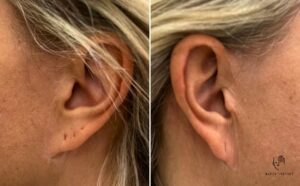Deep plane necklift
Double chin and loose skin on the neck are common aesthetic problems that occur both in men and women. Most plastic surgeons use an operation called a necklift to rejuvenate the neck. However, if the necklift is performed only superficially, the result will only last for a limited time and after a while a recurrence will occur – the neck tissues will loosen again. Therefore, in most cases, I choose a deep plane neck lift for my patients – an advanced technique that focuses on modeling and correcting the deep structures of the neck
Deep plane necklift
What is deep plane neck lift
By the deep plane neck lift technique, we mean an operation in which the surgeon focuses mainly on the deep structures of the neck (deep plane = deep layer). These are indeed to blame for the excessive and aesthetically unpleasing increase in tissue volume in the area under the chin. The fat layer in the subcutaneous layer increases, but especially the fat in the deep layer under the muscle called the platysma increases. Furthermore, the tissues loosen and, as a result, the submandibular salivary glands descend. At the same time, as we age, the bone support of the chin atrophies, and this means that the volume that was originally hidden by the bone shell of the lower jaw does not fit into this shell and is visible under the chin. Each person is individual, and for the final solution of the condition, the operator must decide only during the operation according to the findings.
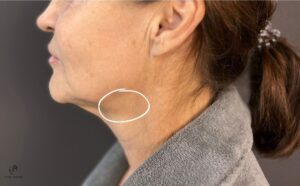
Figure.: Submandibular salivary gland before resection
Why deep plane necklift?
It has been shown that the removal of the double chin, for example, by liposuction alone or other less invasive techniques may not be completely successful in achieving the desired jaw contour, especially because the deepest deposits of fat stored under the muscle are not removed and any other problem structures are not treated.
Also, simply lifting the neck structures during a simpler necklift often fails in the long term.
„It’s similar to trying to shrink a beer belly with belted pants. Likewise, the neck and chin cannot be reduced by shrinking the neck structures. The belly band, as well as the neck structures, will eventually loosen and return to their original state. However, if the belly looses weight, we can pull it down easily with a belt. The same applies to neck surgery. Belly slimming is the equivalent of an operation in the depth of the neck – a deep plane necklift.“
MUDr. Radek Lhotský
This is a technique intended for experienced surgeons who know very well the anatomical area and the operative techniques of facial aesthetic surgery. The great advantage of this advanced technique is the durability of the result, which is not affected by significant weight changes in the future. Therefore, recently many patients prefer to choose the deep plane technique.
Principles of deep plane necklift
The essence of the operation is therefore the removal of any excess tissues in the neck area in order to achieve the best possible contour of the transition between the jaw and the neck, and thus the youthful and fresh appearance of this area. This mainly involves the removal of excessive accumulation of fat between the muscles in the chin area, the reduction of the submandibular gland, or the reduction of excess muscle that forms the floor of the oral cavity, and other advanced operative maneuvers. At the same time, with this technique, fat deposits in the subcutaneous tissue (where there is not much fat) are conservatively removed, and finally the muscle of the superficial layer of the neck – the platysma – is lifted. During the procedure itself, the skin in younger patients shapes itself into a new contour, or in case of a larger excess, it is also necessary to remove it through an incision behind the auricle (extended necklift).
The operation can be performed alone, especially in younger patients who do not yet have a droopy of the face area, or it can be combined with a deep plane facelifting, i.e. a total lift of the face.
Additional maneuvers
Submandibular salivary gland
An interesting and very effective part of the deep plane necklift is the partial resection of the submandibular gland. This gland is one of many glands that produce saliva. Its size affects the fullness of the submental area and the lack of a sharp contour of the neck. In fuller necks, the gland can be identified by palpation as a larger or smaller ball about 1.5 cm in size, which is accentuated by the pressure of the tongue against the palate, in thinner necks it is visible from the side.
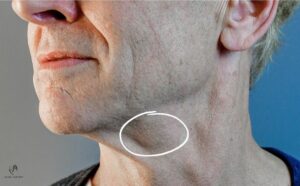
Figure: Submandibular salivary gland before resection
In about a third of patients who come for neck surgery, it is appropriate to partially reduce the gland. We reduce the superficial lobe of the gland, most of the gland then remains in the depth of the floor of the oral cavity and its function is preserved. Mendelson et al. in a sample of 112 patients demonstrated no risk of insufficient saliva production after superficial lobe removal (1). The main risks are especially acute bleeding in the early postoperative period and the risk of a salivary fistula from leaking saliva into the surgical area. At the same time, there is a higher risk of temporary disruption of the innervation of the lower lip, due to the close passage of one of the branches of the facial nerve on the outer side of the gland. However, these risks are small. We perform the resection using special equipment that is used in the operation of other glands on the body, for example the pancreas, thyroid gland, etc., which requires relatively expensive consumables. Therefore, the price of this additional procedure is added to the basic procedure for patients who require it. Without reduction of the gland, in some patients the result will never be as effective as with it.
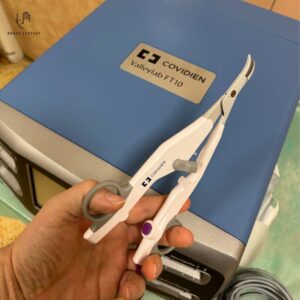
Bild: Das Instrument Ligasure Exact, das zur Reduktion der Unterkieferspeicheldrüse verwendet wird
„In order to regain a firm, sharp and defined jawline, it is necessary to release the fixation points of the tissues on the face and move the middle drooping mobile part upwards and backwards and other maneuvers. These maneuvers are performed in the deep layer of the face, as part of the deep plane face and necklift method. Only then is it possible to achieve a perfect jawline as we see in the illustration.“ MUDr. Radek Lhotský
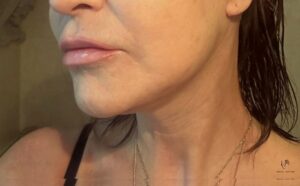
Fig.: Perfect jawline after deep plane facelift and necklift
Diet is an essential part of care after salivary gland resection. The aim is to limit the stimulation of the salivary gland in order to avoid the production of saliva in the neck area with the need for subsequent drainage. Diet after salivary gland trimming may be found here.

Fig.: Comparison of the situation before submandibular gland reduction and after its trimming
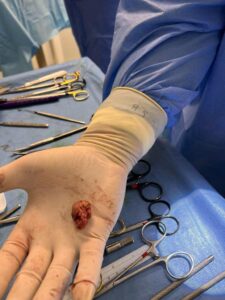 Fig.: Removed salivary gland within a Deep plane necklift surgery
Fig.: Removed salivary gland within a Deep plane necklift surgery
Why is chin liposuction unsuitable minimally invasive alternative to deep necklift?
Liposuction in its principle focuses on fat layers stored under the skin. This fat layer on the neck is very thin in most people, about 0.5 cm in diameter. Only in very obese patients can it reach larger volumes. The fat layer in the subcutaneous tissue is also responsible for the youthful appearance of the skin, hydration and tightened appearance. If we remove this very thin layer with liposuction, scarring of the skin to the muscle occurs, unevenness occurs and the skin loses its nice, tight appearance. That’s why I only minimally recommend liposuction and rather use it as an additional maneuver as part of a necklift if the layers of fat are excessive in some places. The idea that we can smooth out the unsharp contours of the neck with liposuction is completely wrong and the procedure can lead to dissatisfaction and frustration due to not achieving the desired result.
Earlobes
In the elderly people, it is possible to see that the earlobes lengthen and atrophy. It is a natural process, atrophy occurs everywhere on the body. Sometimes more, sometimes less. As a part of the procedure in this area (either the necklift itself or rather as part of the deep plane facelift), it is really possible to perform the correction of the lobes as well. We solve atrophy by applying a small amount of fat, and lengthening by resection of the lobe.
If the patient has already had facelift surgery in the past, we encounter the so-called pixie ear deformity as shown on this image:
Fig.: Pixie ear deformity of the earlobes
It is a deformity that is caused by excessive pulling of the skin, when the subcutaneous so-called SMAS layer was not sufficiently released and fixed, and the surgeon concentrated all the lifting pull just to the skin. It is bad. The lobule cannot withstand the pull and stretches and the scar migrates and is visible as in this image. In the deep plane technique, all the forces that could act on the lobule are concentrated on the deep part, and the skin is only loosely attached to the lobule and freely laid to be stitched, so that no forces could act on the lobule.
Here is another big advantage in the deep plane technique, and it basically applies to all the skin that is loose during the lift. There is no traction on any part of the scar nor lobule. Therefore, the scars are very thin and do not migrate.
The correction of this deformity is a complete redesign of the lifting operation on the deep plane, loosening and anchoring of the deep structures properly and placing the skin without traction on the suture. Simple excision of the scar does not solve this problem because the traction will re-engage and the lobule will pull out again and scare will stretch.
Revision surgery after a previous lift
In the past, only and exclusively lifting operations were used, that performed the lift only within the skin or surface layers, either by so-called SMAS plication, resection or its displacement, without loosening the fibrous attachments in the deep layer. This meant that the effects were not and could not be durable and perfect. I have even come across the opinion of renowned experts in the field who still claim that there is no need to do anything with the neck. That is wrong. A well-contoured neck is essential for overall facial rejuvenation. Therefore, I consider the deep necklift technique to be one of the most important for achieving significant rejuvenation.
There is a partial advantage to this deep plane technique in the case of previous surgeries. In principle, we say that where the previous operation with dissection ends, the deep plane just beggins. During the revision, we often skip over the original operated terrain and get to the still untouched terrain. This also proves that the effect is completely different. However, the problem with revision procedures is the excessive amount of removed skin, pulled out lobes and generally scarred tissue (for example, after previously performed liposuction of the neck, etc.). We often do not know what we will actually encounter during the revision and how the operation will be performed. That is why revision surgery tends to be more demanding, longer and, unfortunately, more expensive. Sometimes the repair of a previously performed lifting is not completely possible and it is necessary to take this into account.
Fillers, lifting threads and facelifting
The situation in our surgery is further aggravated by repeatedly applied fillers. Filling materials can be absorbable or non-absorbable. Both of these materials induce changes in the tissues, persist even longer than the manufacturer declares, and generally worsen the quality of the tissue where the operation takes place. If you regularly apply fillers or lifting threads, prepare for problems, especially longer-lasting swelling and poorer healing, which may or may not affect the result. If possible, and you are considering a facelift in the future, avoid using these substances and materials, or have them dissolved beforehand.
Fatgrafting in facelifting
My favorite addition to a facelift or necklift is fat grafting – the transfer of one’s own fat tissue to the face area.
Fat, as already mentioned in other parts of my website, is a very interesting material that comes from the body’s own fat deposits. The collection is carried out at the beginning of the operation and after processing it is applied to the planned locations. Fat has many effects, one of them is the addition of missing volume, another is the correction of various irregularities, wrinkles or shadows, but also, for example, a change in the color of the skin in places where the muscles or deeper structures that are visible through the skin and cause shadows show through.
An interesting form of specially processed fat is the so-called nanofatgraft. It is fat that has been stripped of fat cells, so it is not actually fat. This material is significant in that the fat cells are destroyed and it contains only so-called stem cells. These cells are in a resting state, but after the destruction of the surrounding fat cells, they are activated in order to repair this damage. It is a simplified principle of the mechanism, however, the activation of stem cells is to start the process of repair and regeneration. It is strange that regeneration does not only take place in the sense of repairing destroyed fat cells, but also restoration and repair of other damaged tissues. Using nanofatgraft, it is then possible to solve atrophy and tissue damage due to aging, regenerate the skin, improve hypertrophic or atrophic scars, improve hyperpigmentation or hypopigmentation and many other effects. During a facelift or necklift, I use it to improve the skin, hydrate and improve the quality of the lips, overall improvement of the SMAS layer, which is responsible for the quality of the skin attached to it, and a lot of other possibilities.
Although the exact mechanism of action of nanofat grafting is not yet known, the effects are widely published and the results of individual applications are freely available. (3) (5)
Another possibility of using nanofat grafting is to mix it with your own plasma to further improve the effect. (4)
Detailed consultation is required before surgery
Deep plane necklift is a complex operation that we generally perform under general anesthesia, and the preparation for the operation also corresponds to this.If you are considering neck rejuvenation through a deep plane necklift, we will first meet for a consultation, during which you will tell me your expectations and the goal of the operation. Through the examination, I will determine the degree of loosening of the tissues in the neck area, the elasticity of the skin and possibly the amount of accumulated fat, and we will evaluate the size of the submandibular gland.
The consultation can also be done online. But for that I need precise illustrative photos. You can read how to take photos for an online consultation here.
If it turns out that you are a suitable candidate for a deep plane necklift and you are familiar with the risks to which you will agree, we will agree on the date of the operation. You will receive all pre-operative instructions and a list of examinations that must be completed before the operation (most of them, however, can be done at the Prague clinic on site when you arrive).
The most important precautions before surgery include:
– reduce or preferably completely avoid smoking at least 2-3 weeks before surgery – smoking has a negative effect on wound healing
– stop or modify the use of blood-thinning drugs (e.g. Acylpyrine, Alnagon, Anopyrin, Godasal, Aspirin, Mironal or Warfarin, but also any herbal nutritional supplements that sometimes worsen blood clotting)
– pre-operative examination including ECG, laboratory tests (blood count, basic biochemical examination, bleeding and coagulation, laboratory tests for sexually transmitted diseases – HIV, syphilis and liver diseases – jaundice)
Course of surgery
The procedure is performed under general anesthesia. It is not possible to perform some maneuvers under local anesthesia due to intolerance of the pain they can cause. Through an incision of 4 to 5 cm in length, which is hidden under the chin, we dissect the individual layers of tissues – fat, muscles and platysma, salivary gland, … and stitch the platysma muscles together for chin support. After performing all operative maneuvers, we carefully close the wound on the chin with several non-absorbable sutures. The operation very often includes an incision around the earlobe and behind the pinna so that the platysma muscle can be stretched to the sides and at the same time any excess skin can be removed. The newest technique for improving the quality of the skin of the neck as part of a deep necklift is to leave a part of the skin and the platysma muscle on the neck connected without mutual separation – the preservation necklift technique. This does not disturb the blood circulation of the skin, and its quality, and by tightenning the underlying muscle, the skin is simultaneously smoothed, lifted and significantly improved in appearance. This is only possible with the deep plane technique, because the lifting maneuver takes place under this platysma muscle, not under the skin as with all other facelift techniques used – in this it is unique and achieves significantly better results.
Possible complications of deep plane necklift
The main risk of this operation is bleeding in the early postoperative period and, in the case of a procedure involving the treatment of the submandibular gland, the accumulation of fluid in the neck area during saliva production. The risk of damage to the nerves that occur in the vicinity is very small, because they are located rather outside the immediate operative field. However, in the case of deep neck dissection, lower lip motility disorders sometimes occur, when the so-called lip depressor does not work quite properly and deformity can occur. This is the result of manipulation in the deep layer, where there are neck parts of the facial muscle and the so-called marginal branch of the facial muscle, which innervate the platysma muscle and the muscles of the lower lip. This disorder can have many causes and the localization of the damage site is not always precisely detectable, however, in almost 100% of cases, the disorders are reversible and the innervation fully recovers within the next 2-3 months after the operation due to the complexity and mutually duplicated innervation and the possibility of regeneration of temporarily non-functional nerves. If it occurs, we recommend the administration of vitamin B, E, D and patience till full recovery. Deformity can be camouflaged with botox administration to the uninjured side, which temporarily eliminates the function of the opposite depressor muscle.
Healing and recovery
Immediately after the operation, the development of swelling will gradually begin and there may be larger or smaller bruises. Drains can be taken out of the wounds, the role of which is to prevent fluid accumulation and thus simplify wound healing. The swelling is most pronounced about a week after the operation and then gradually subsides. Maximum swelling and thus hardening is often occurring in the area under the chin. This is related to the disruption of the lymphatic drainage of the area and disappears within up to 3 months of the operation.
You can take a shower already 24 hours after the operation.
For a period of at least 7 days, I recommend a resting regimen with restriction of bending and lifting of the head. I recommend a rather soft diet, avoiding excessive opening of the mouth – these are instructions to avoid tearing the fixation of the deep layer. You may feel a strong pull in the area of the neck or more difficult swallowing. After a week, it is already possible to use light make-up. It is necessary to limit sports activities for a period of up to 6 weeks. We minimize the compressive head band after the facelift for the first few days. It’s more of a nuisance than a help with the swelling. The swelling must subside by its own circulation through the lymphatic channels, which the compressiong tends to suppress even more. Lymphatic massages performed by a physiotherapist are suitable. Since facelifts are ischemic interventions, hyperbaric oxygen therapy can help to improve healing after any such surgery, as Dr Jacono from New York demonstrated in his study (2). This treatment may be available at commercial establishments near where you live.
Deep plane necklift price
The final price of the surgery is influenced by its complexity and duration of surgery, The price is calculated after the consultation with the doctor.
Usual optional additional procedures in combination with a deep plane necklift:
- deep plane facelift
- fatgrafting
- nanofatgrafting
- correction of ear lobe
- submandibular salivary gland trimming
References:
1) Mendelson BC, Tutino R. Submandibular Gland Reduction in Aesthetic Surgery of the Neck: Review of 112 Consecutive Cases. Plast Reconstr Surg. 2015 Sep;136(3):463-471. doi: 10.1097/PRS.0000000000001526. PMID: 25989302; PMCID: PMC4548544.
2) Stong BC, Jacono AA. Effect of perioperative hyperbaric oxygen on bruising in face-lifts. Arch Facial Plast Surg. 2010 Sep-Oct;12(5):356-8. doi: 10.1001/archfacial.2010.66. PMID: 20855782.
3) Tonnard P, Verpaele A, Peeters G, Hamdi M, Cornelissen M, Declercq H. Nanofat grafting: basic research and clinical applications. Plast Reconstr Surg. 2013 Oct;132(4):1017-1026. doi: 10.1097/PRS.0b013e31829fe1b0. PMID: 23783059.
4) Talei B, Ziai H. PHAT Lips and PHAT Face: Platelet Hybridized Adipose Therapy for Superficial Musculoaponeurotic System and Dermal Rejuvenation. Facial Plast Surg. 2023 Nov 20. doi: 10.1055/a-2188-8608. Epub ahead of print. PMID: 37816491.
5) Tonnard P, Verpaele A, Carvas M. Fat Grafting for Facial Rejuvenation with Nanofat Grafts. Clin Plast Surg. 2020 Jan;47(1):53-62. doi: 10.1016/j.cps.2019.08.006. Epub 2019 Oct 28. PMID: 31739897.
Quick info
Anesthesia: general
Make-up: after a week
Sport: after 4 to 6 weeks
Hospitalization: 1 to 2 days
Back to normal life: after 2 to 3 weeks
Fotogalerie
Recenze
Arrange a date for your consultation
Please contact us via form bellow or by phone.
+420 224 284 421 / +420 776 553 244
ADRESSE
MUDr. Radek Lhotsky
Formé Clinic
Jeseniova 30
130 00 Prag 3
Tschechische Republik


